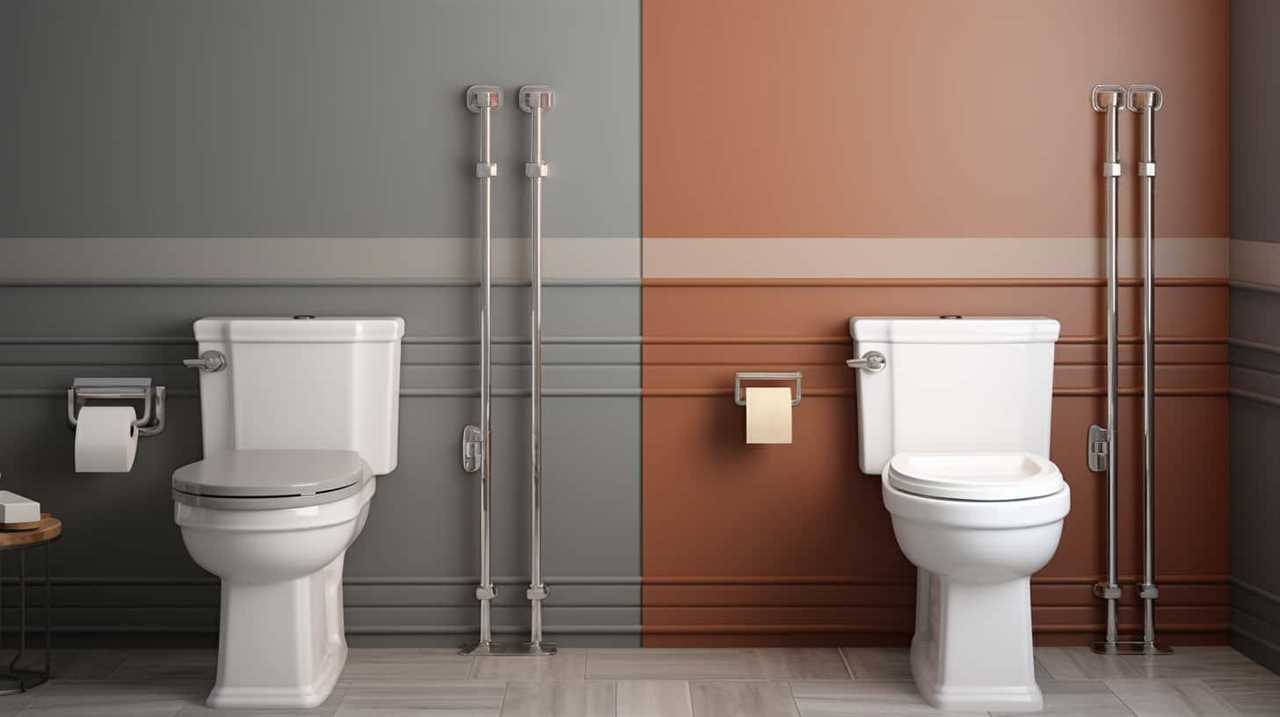Are you tired of dealing with leaks and water damage in your bathtub?
Well, it’s time to take matters into your own hands and learn how to silicone caulk your bathtub.
By following these simple steps, you’ll be able to seal any cracks or gaps, ensuring a watertight seal that will protect your bathroom from further damage.
So grab your caulking gun and get ready to transform your bathtub into a leak-free oasis.
Let’s dive in and get started!
Key Takeaways
- Consider factors such as durability and water resistance when choosing caulk.
- Thoroughly clean the surface before applying caulk.
- Choose a silicone caulk designed for bathroom use.
- Allow sufficient curing time and regularly inspect and maintain the caulk.
Selecting the Right Caulk for Your Bathtub
When selecting the right caulk for your bathtub, it’s important to consider factors such as durability and water resistance. Choosing the right color is also crucial to ensure a seamless and aesthetically pleasing finish.
To start, you will need to remove the old caulk. Begin by using a caulk removal tool or a razor blade to carefully scrape away the old caulk. Make sure to clean the area thoroughly to remove any residue or debris.
Once the old caulk is removed, you can begin the process of selecting the right caulk for your bathtub. Look for a caulk that is specifically designed for use in wet areas, as it will provide superior water resistance and durability. Additionally, consider the color that best matches your bathtub and bathroom decor.
Taking the time to choose the right caulk and properly remove the old caulk will ensure a successful and long-lasting caulking job.
Preparing the Surface for Caulking
Before you start, make sure to thoroughly clean the surface to ensure proper adhesion of the caulk. Proper surface cleaning is essential for a successful caulk application.
First, remove any old caulk by using a caulk removal tool or a utility knife. Carefully scrape off the old caulk, making sure to remove all traces of it.
Next, clean the surface with a mild detergent or a specialized caulk cleaner to remove any dirt, grime, or soap residue. Use a scrub brush or sponge to thoroughly clean the area.
Rinse the surface with clean water and allow it to dry completely before applying new caulk. Taking the time to properly clean the surface will ensure that the new caulk adheres well and provides a long-lasting seal.
Applying the Silicone Caulk to Your Bathtub
To ensure a smooth application, it’s important to evenly distribute the caulk along the edges of your tub. Here are some tips for a perfect caulk line and common mistakes to avoid when caulking a bathtub:
-
Choose the right caulk: Select a silicone caulk designed for bathroom use. It should be waterproof and mold-resistant.
-
Prep the surface: Clean the area thoroughly and remove any old caulk or residue. Use a mildew remover to eliminate any mold or mildew.
-
Apply the caulk: Cut the tip of the caulk tube at a 45-degree angle and insert it into a caulk gun. Hold the gun at a 45-degree angle and slowly squeeze the trigger to apply a thin, even bead of caulk along the joint.
-
Smooth the caulk line: Use a caulk smoothing tool or your finger dipped in water to smooth the caulk line and remove any excess. Wipe away any excess caulk with a damp cloth.
Smoothing and Finishing the Caulk
After applying the caulk, it’s important to smooth and finish the line to ensure a professional-looking result. To achieve this, you can use buffing and polishing techniques.
Start by allowing the caulk to cure for the recommended time. Once it’s dry, you can begin the smoothing process. Use a caulk removal tool or a putty knife to gently scrape away any excess caulk. Be careful not to damage the surrounding surfaces.
Next, dampen a clean cloth with rubbing alcohol and wipe along the caulk line to remove any residue. Finally, use a caulk finishing tool or your finger to smooth the caulk line, ensuring it blends seamlessly with the bathtub surface.
By following these steps, you can achieve a polished and professional finish.
Now that you’ve learned how to smooth and finish the caulk line, let’s move on to the next step: curing and maintaining the caulk in your bathtub.
Curing and Maintaining the Caulk in Your Bathtub
Maintaining the caulk in your bathtub is essential for ensuring its longevity and preventing any potential water damage. Here are four important steps to follow in order to properly cure and maintain the caulk in your bathtub:
-
Allow sufficient curing time: After applying the caulk, it is crucial to give it enough time to properly cure. This typically takes about 24 to 48 hours, but it’s best to check the manufacturer’s instructions for specific curing times.
-
Keep the area dry: Moisture can hinder the curing process and promote the growth of mold and mildew. To prevent this, make sure to keep the area dry during the curing period.
-
Regularly inspect the caulk: After the initial curing, it is important to regularly inspect the caulk for any signs of wear or damage. Cracks or gaps should be promptly repaired to prevent water seepage.
-
Clean and maintain the caulk: Regularly clean the caulk with a mild detergent and water to remove any dirt or grime that may accumulate. Additionally, consider applying a silicone caulk sealer to enhance its durability and prevent mold growth.
Frequently Asked Questions
How Long Does It Take for Silicone Caulk to Dry?
It usually takes around 24 to 48 hours for silicone caulk to fully dry. To remove silicone caulk from your bathtub, you can use a caulk remover tool or a mixture of vinegar and water. Some of the best brands of silicone caulk for bathtubs include GE Silicone II and Dap 3.0.
Can I Use Silicone Caulk on a Fiberglass Bathtub?
Using silicone caulk on a fiberglass bathtub can be a good option for sealing and preventing leaks. It’s a simple process that can be done in a few easy steps. Here’s how to do it.
Can I Apply Silicone Caulk Over Existing Caulk?
Yes, you can apply new silicone caulk over existing caulk, but it’s best to remove the old caulk first for better adhesion. Use a caulk remover tool or a putty knife to carefully scrape off the old caulk before applying the new one.
How Often Should I Reapply Silicone Caulk in My Bathtub?
You may think that silicone caulk lasts forever, but sadly, it doesn’t. To maintain a watertight seal, it’s recommended to reapply silicone caulk in your bathtub every 5-10 years, depending on wear and tear.
Can I Use Silicone Caulk in Areas That Are Constantly Exposed to Water?
To answer your question, yes, you can use silicone caulk in areas constantly exposed to water. Silicone is a water resistant caulk that works well in wet areas. However, it’s important to consider the pros and cons before making a decision.
Conclusion
So there you have it, a complete guide on how to silicone caulk your bathtub. By following these steps, you can ensure a professional-looking finish and a watertight seal that will last for years to come. Remember to choose the right caulk for your bathtub, properly prepare the surface, and apply the silicone caulk evenly.
To illustrate the importance of proper caulk application, let’s consider a hypothetical scenario. Imagine coming home after a long day, looking forward to a relaxing bath, only to find water leaking from your bathtub onto the floor. This could have been avoided if the caulk had been applied correctly.
By taking the time to follow these instructions, you can prevent such a frustrating situation and enjoy your bath worry-free.










